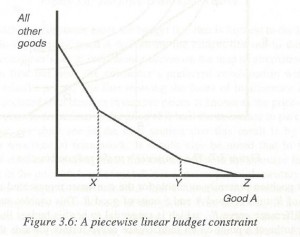Earl – Consumer budget constraints with bulk discounts
The budget constraint
Peter Earl on the case of bulk discounts.
The following is from pp.43-44 of Earl, P. E. (1995). Microeconomics for business and marketing: lectures, cases, and worked essays. Aldershot, Hants, England: E. Elgar.
If we draw a linear budget constraint we are assuming that consumers cannot get quantity discounts and do not bid up the price of a product if they try to buy more of it. Quantity discounts are, of course, quite common in practice in various guises. Figure 3.6 illustrates the type of case in which the price charged to the consumer on marginal units falls discontinuously as two purchasing levels, X and Y, are successively exceeded: it might be that if up to X units are purchased, the price per unit is $6.00, but additional units between X and Y are charged at only $5.00 and units in excess of Y are charged at only $4.00. The resulting budget constraint in this case is a series of linear segments, known technically as a piecewise linear constraint.
[Ed. Note: If the diagram were for two goods, A and B, it could be considered to represent the situation where there is a price for small quantities and a lower price for larger quantities of each good. The central section would then describe low quantity purchases of both goods, with the outer sections describing bulk purchases of Good B on the left and of Good A on the right.]
